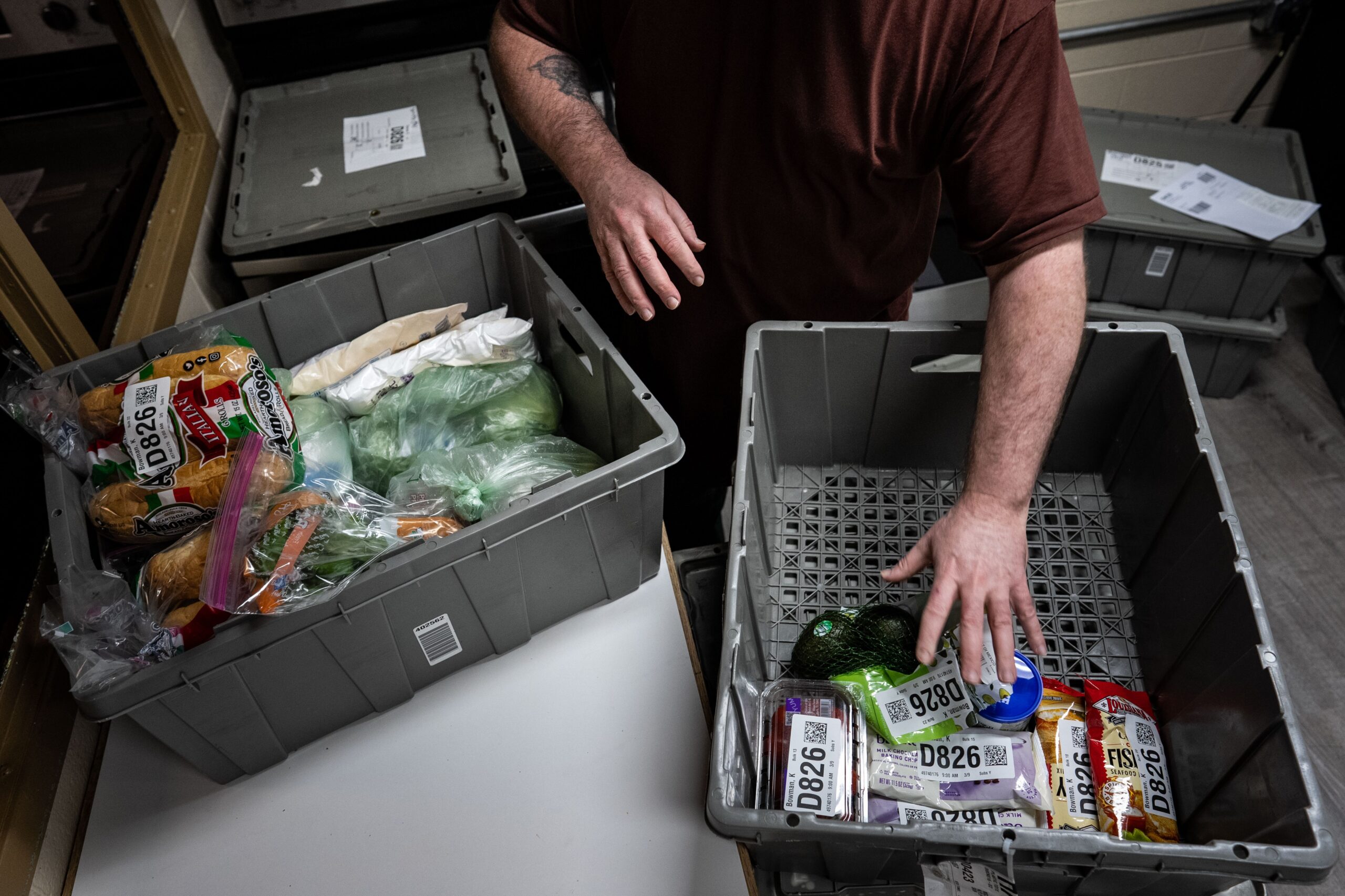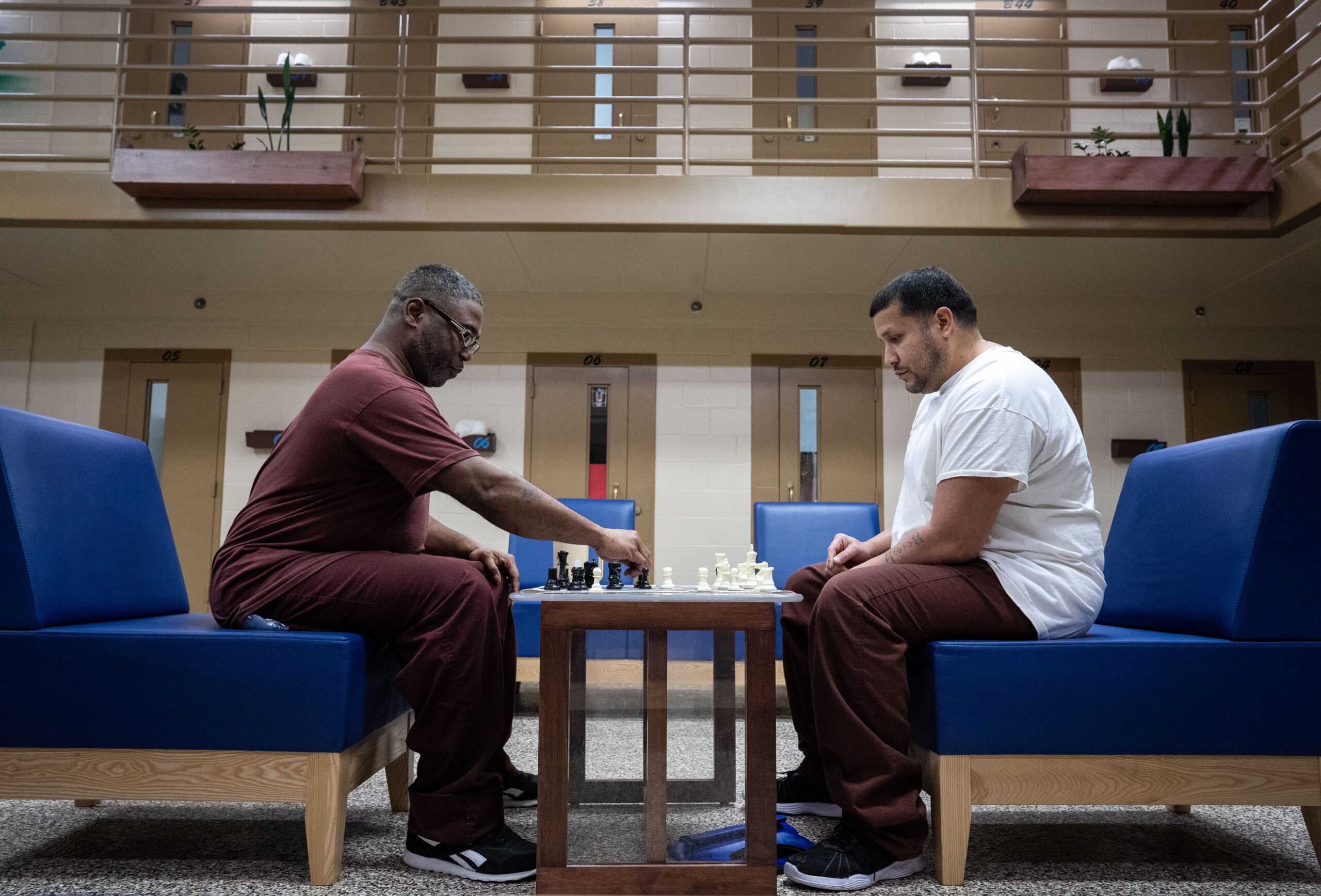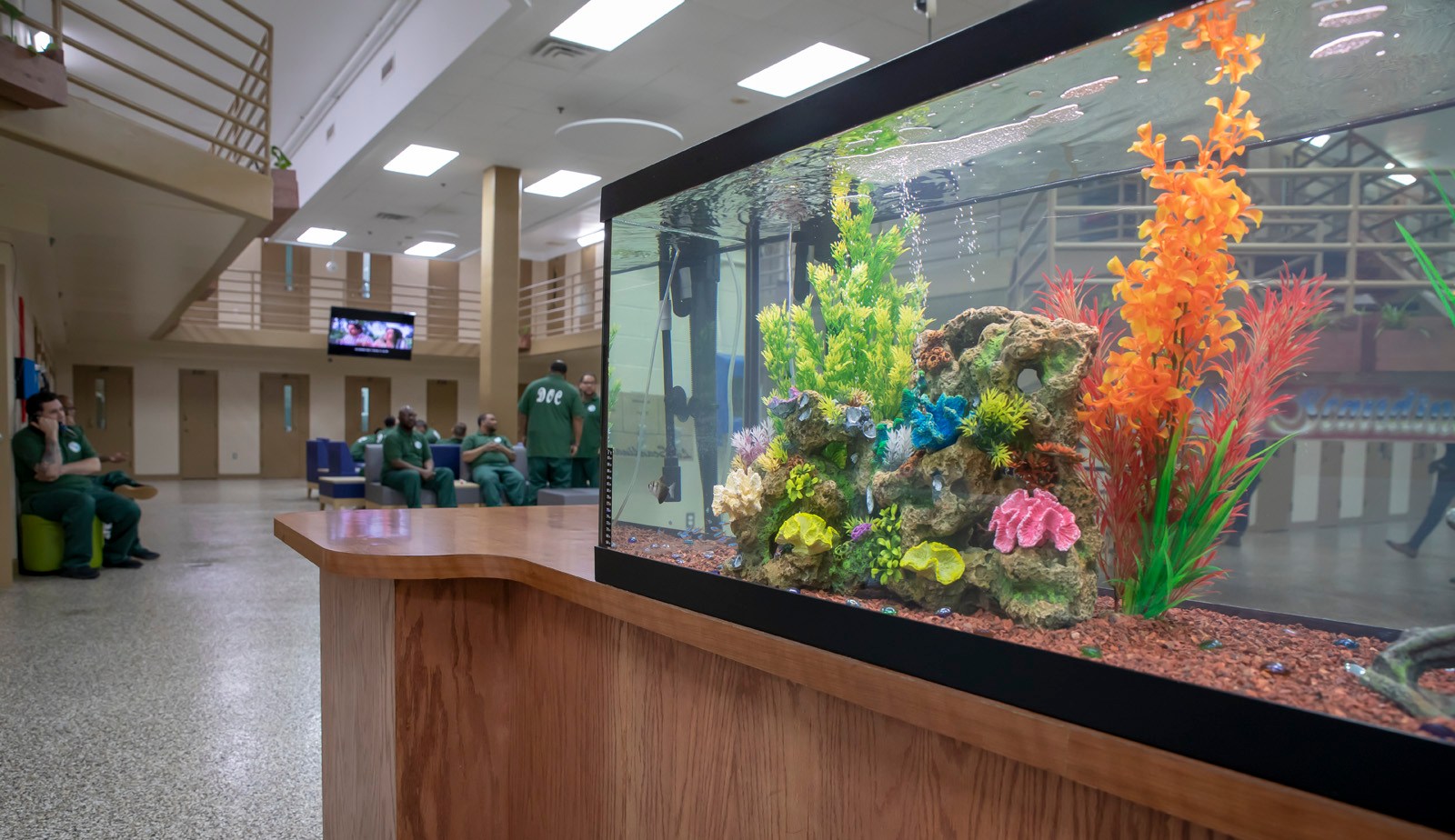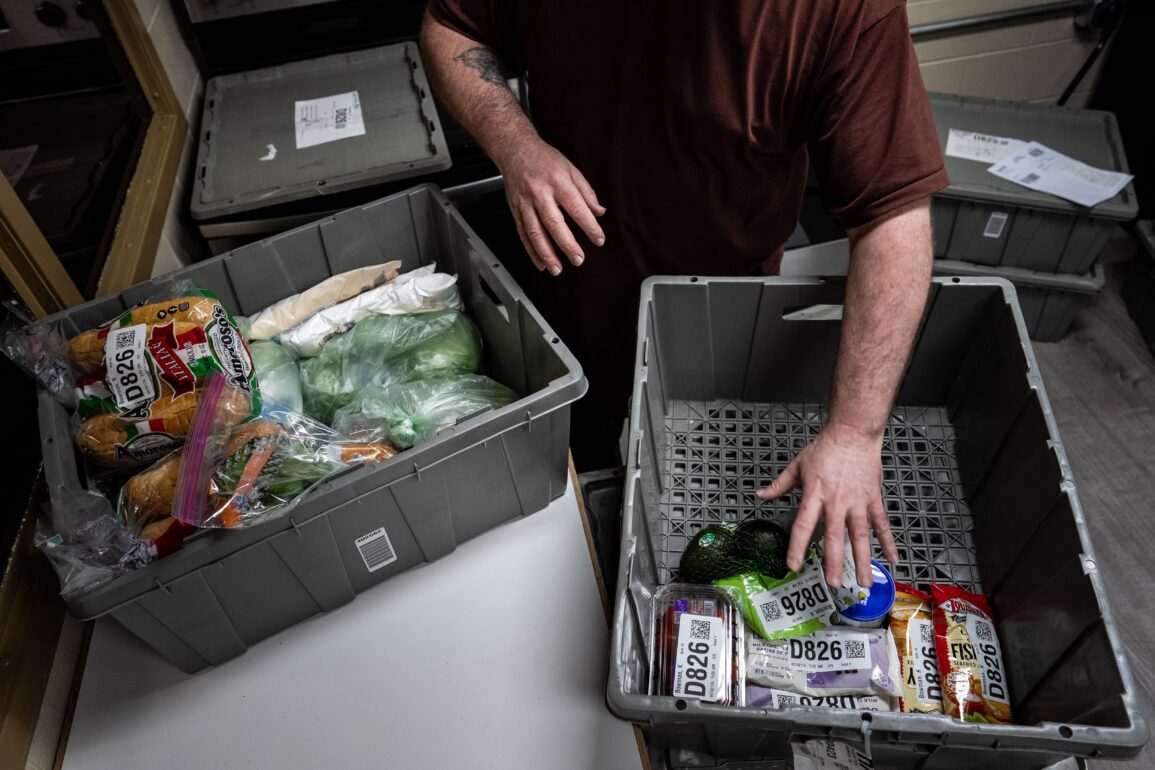Dogs and cats wander past a fish tank that is bubbling quietly surrounded by a jungle of pot plants. “It’s like Dr Dolittle around here,” says Gina Clark, the superintendent of State Correctional Institution Chester. With its Zen garden, cappuccino machine, pastel sofas, breadmaker and therapy room, this bright and airy facility near Philadelphia could be a spa retreat or a luxury hotel. In fact, it is an innovative wing at a medium security jail next to a giant casino at the epicentre of the opioid crisis in Pennsylvania.
The people who live here have all committed serious crimes — some of them horrendous offences — but they are treated with respect by the staff and known as “residents” rather than “inmates”. They each have an individual cell with a desk, a television and a fridge. A shared communal living area includes a ping-pong table, gym equipment, chessboard, pool table and Xbox. There are telephones lined up along one wall for prisoners to call home.
The focus in the unit is on normality, tranquillity and reintegration into the community upon release. Residents order groceries once a week and cook their own food in the well-equipped kitchen — there is even an air fryer. They do their laundry, go out to work and attend lectures run by Wharton business school. They can earn a wage about ten times higher than standard prison pay and are allowed to use computers and tablets with internet access under supervision.
The atmosphere is completely different from the mood in a regular jail. Instead of slamming doors and jangling keys, the wing is painted in calming colours and has sound-dampening panels as well as floor coverings designed to create a peaceful environment. Prisoners wear comfortable polo shirts rather than scratchy overalls and spend most of the day out of their cells, freely wandering around. The staff are known as “contact officers” rather than prison guards and play pool with the inmates to build trust. The murderers are the mentors.
Advertisement
The unit for 64 men is part of a groundbreaking experiment being run by an international team of criminologists in collaboration with the Pennsylvania Department of Corrections, which is looking at the effectiveness of different types of prison regime. Known as “Little Scandinavia”, the wing is modelled on jails in Norway, Sweden and Denmark, where the emphasis is on treatment and rehabilitation rather than punishment. The officers who work on the unit have travelled to Norway and Sweden to see how they do things differently and had extra training to give them the therapeutic skills needed to deliver the new approach.
By contrast, the rest of Chester prison, which holds about 1,000 criminals, operates as a traditional American penitentiary. The priority is control. Many of these inmates remain locked in their cells for large parts of the day, receive their food on a tray and never see a washing machine. Most prisoners share a cell and the officers see their primary role as maintaining order. Violence, self-harm and drugs are rife. Two days after I visited, there was a suicide at the jail.

Prisoners can order their own fresh food and then cook it. “In Norway, the recidivism rate after two years is under 20 per cent, compared with 53 per cent in the US and 39 per cent in England and Wales”
GETTY IMAGES
As part of the randomised controlled trial, inmates are allocated by lottery to the Little Scandinavia wing. For the experiment to be credible, it is important that the “residents” are representative of the general prison population and so being sent to the more liberal unit is not treated as a reward for good behaviour. The progress of the two groups of prisoners is being tracked by academics from America and Norway who compare violence levels, staff morale and reoffending rates in the Nordic unit with those in the rest of the institution.
The programme is pitting two extremes against one another. The US has one of the highest rates of incarceration in the western world, with 541 people in prison for every 100,000 of the national population. In Norway the number is 54 (in England and Wales it is 134). The US and Scandinavian criminal justice systems represent the tough and tender ends of the spectrum. While the Nordic countries prefer to “hug a hoodie”, as David Cameron once put it, the death penalty is still legal in some American states, including Pennsylvania.
It is the first time anyone in the world has tried to put evidence at the heart of policymaking around law and order, an issue that is highly politicised on both sides of the Atlantic. The research project only began in 2019 and did not become fully operational until 2022, so it is early days but the results so far are fascinating. In Little Scandinavia, violence and self-harm are virtually non-existent and staff morale is much higher than in the rest of the prison.
Advertisement
Jordan Hyatt, a professor from Drexel University, Philadelphia, who is leading the programme with Synove Andersen, a colleague from Oslo University, says serious misconduct and the use of restricted housing (the punishment block where prisoners go for rule violations) “are down meaningfully” on the Nordic wing. “In some cases, they are down by almost half. The staff on the unit also report better health outcomes, better engagement at work and better rapport with their colleagues than they had before.” Recruitment and retention, a growing problem in the UK and the US, are not an issue in Little Scandinavia. When the project started, prison officers had to be pressured into signing up for the risky new programme. “Now, when a spot on the unit opens up, there’s a waiting list of people who want to take that spot,” Hyatt says.
Gina Clark — an avid Star Wars and Game of Thrones fan who has a poster of a dragon on her office wall and a Master Yoda mat in the bathroom — has worked in US “corrections” for more than 20 years. She inherited the Little Scandinavia pilot when she became the superintendent or governor of Chester two years ago. She could not believe it when she heard about some of the innovations that were being trialled on the Nordic wing. “I started my career in one of the older jails. We had death row; it was very similar to Shawshank in the movie or Alcatraz. I thought, ‘What, they’re going to have a kitchen? That’s crazy! The officers are going to interact with the prisoners? Where do you draw the line?’ I was a little sceptical, but it changed me.” She put her foot down when the prisoners tried to order a chef’s block of knives. “I said, no, I can’t go there, but they do pretty well without them; they cut with plastic knives. And there are a lot of things that I have said yes to. If it’s working, why stop it?”

Inmates in the unit playing chess. “I can honestly say that I’ve only had one incident of violence and zero staff assaults on the Scandi unit since it opened”
GETTY IMAGES
The evidence so far has been persuasive, Clark says. She expected it to be “chaos” but in fact Little Scandinavia is far safer than the rest of the prison. “I have fights and incidents quite often [on the other blocks]. There are weeks that we’re responding two or three times to an inmate-on-inmate fight,” the superintendent explains. “I can honestly say that I’ve only had one incident of violence and zero staff assaults on the Scandi unit since it opened. That’s pretty good to me. For a jailer, it’s safer for me to come into work and step onto that unit than it is for me to come into work and step onto another unit. You can feel the difference. It’s calmer. The fish are calming, the plants are calming, the colours are calming.”
The inmates are happier, more open and less aggressive. “They’re in single cells, so if they get into an argument with someone they can go back to their cell and they don’t have to interact with another person. It’s their own space — they can go in and do what they need to do. I’ve had a lot of them say to me, ‘I haven’t cried in years. I didn’t want to show that weakness because I shared a cell with someone.’ They’re able to cry now because who’s going to see it? They’re by themselves so they can let their emotions out.”
Staff morale has also been transformed. There are three times as many prison officers for each inmate on the Little Scandinavia wing and Clark is convinced it is worth the allocation of extra resources. “If you’re talking about retaining staff and what makes them tick, the model that has been created here is definitely the way to go,” she says, although she admits it has required a mindset shift. “Years ago, if I saw an officer playing pool with an inmate, I would have broken that up. Here, we encourage it. The officers are connecting to inmates to help them get to a place of trust.”
Advertisement

The unit’s fish tank, which the governor says has a calming effect on inmates
This is not some namby-pamby nonsense, she insists. “A lot of people think that people in jail have committed crimes; they’re terrible human beings. You lock the door and that’s it — they’re out of society, forget about them. That’s not true. A lot of people, especially here at Chester, are addicts. A lot of people just made bad mistakes and bad choices in their life. They haven’t come from a background of a mum and a dad and a brother and a dog and the white picket fence. The education is not there. So people that are incarcerated, statistically, have already had a number of things go against them, which leads them into a life of crime. They’re not going tobe here for ever. Most of the people incarcerated are going to go home. So don’t you want them to be better people going home than they were when they came in? Because at the end of the day, they’re going to be our neighbours.”
Clark believes the Little Scandinavia approach makes it more likely that offenders will leave prison able to become law-abiding members of society. “You can never really predict individual behaviour, but I feel that a unit like this gives them more of a chance to be successful. It’s just about being human beings and treating people with dignity and respect,” she says. “If we can change the criminal thinking of an individual, if we can get to the real reason why they committed crimes in the first place — was it trauma? Was it because they were not educated? Was it because of addiction? If you can get to the roots of the crime, deal with those and then give them the tools to be successful, a sense of normality — everything that Little Scandinavia does — in the end you probably will see good results.”
The unit is more expensive to run. The cost to house a prisoner in the regular jail is $190.19 (£145) per inmate per day; Little Scandinavia costs only around $2 more per person but there are other outgoings. Around $410,000 was spent at the start of the pilot to reconfigure the block and there are higher staffing costs, although no more than on other specialist wings. These are hard to quantify because they are not broken down across the jail. But the superintendent is convinced that the investment will be repaid many times over. “If you look at the cost effectiveness of it over ten years, I think you will definitely save money because you don’t have that person going in and out of jail.”
Matt Tomkins, a counsellor on the wing, has the words “sink” and “swim” tattooed on his knuckles. He had been a prison guard for eight years before travelling to Norway with his colleagues as part of the Little Scandinavia project. What blew his mind was the motivation of the officers there. “They said, ‘What isa good day for you?’ Our natural response was, ‘I come in, I don’t get hurt and I go home to my family safe.’ They looked at us and said, ‘That’s it? A good day for us is when we can help change somebody’s life,’ ” Tomkins recalls. “A lightbulb went on in my head.” When he was a regular prison officer his job was “maintaining order and observation. It was just day after day, doing the same thing again. You don’t feel like you have a sense of purpose.
“On Little Scandinavia you are able to do more, and that brings that purpose. There have been multiple times now that I’ve had inmates with whom I’ve worked closely over a period of time, and their parole day comes up and the day before they come to my office. They shake my hand and they say, ‘Thank you for the way that you treated me. Thank you for the way that you talked to me. Thank you for opening my eyes up to my potential for what I can be.’ ”
Advertisement
It is too soon to have statistically robust data on reoffending rates, but Tomkins is convinced they will be significantly down. So far no one released from the Nordic unit has ended up back in jail. “I’m optimistic. People look at what we’re doing with Little Scandinavia and they see the amenities, they see the calmness and the question always comes up, ‘Isn’t this too soft?’ My answer is that if you put them in that environment where they don’t have to look over their shoulders, where they’re in a place where they can focus on bettering themselves and make that positive change, that’s when the treatment and rehabilitation start to work.” In Norway, the recidivism rate after two years is under 20 per cent, compared with 53 per cent in the US and 39 per cent in England and Wales.
For the prisoners there is no contest between the two regimes. In the Little Scandinavia kitchen, Geoff is getting a tray of barbecue chicken out of the oven. He has been on the Scandi unit for 16 months and says he now feels so much better prepared for his release in five months’ time than he would have done on a regular wing. “I’ve been learning to cook, getting the mentality to take care of myself. I do think it helps people make the best of the time you have inside.” His fellow chef Danny has been working in a plumbing shop near the jail. “I’ve got 355 days left inside. I’m ready. When I get out I’m going to pursue a plumbing career.”

Doing the laundry in the unit
Eliezer, 49, was one of the first to move into Little Scandinavia. A lifer, in prison for a serious violent crime, he is responsible for the beautifully painted murals that decorate the walls. “Regular jail is constant fighting, arguments, tension. You feel cramped sharing space with someone you might not get along with, even using the bathroom in front of somebody. Here I almost feel free.” But he insists it is not an easy ride. “The real punishment is not watching your kids grow up or being there to bury your father when he dies. That’s what makes it jail, even here,” he says. “One of our roles as lifers is to mentor the people who are coming through. We help get them grounded, talk to them about what they want to do when they get out. I do my best to inspire them not to throw it all away when they leave this place.”
Richie, 60, who is also serving life, says moving to Little Scandinavia made him realise how bizarre his daily life in jail had been. “This is going to sound strange but one thing that makes a big difference is it’s not a concrete floor. For all my years in prison I would get out of bed and never put my feet on the floor because it’s so cold. You put on all these masks, develop coping mechanisms. You’re always overstimulated; aggression happens. The way of life in prison creates barriers for guys when they go home because they have got so used to never making decisions [about] food, laundry. Here you get to make a lot more choices. To do your shopping and decide what to cook wouldn’t seem much to people on the outside, but it helps you prepare for real life.”
Perhaps the person who best understands the extremities of the criminal justice system is Ricardo, who spent 25 years on death row in another jail before having his death sentence commuted and being transferred to Chester. He has been on the Little Scandinavia wing since last November and says the contrast between the two experiences of prison is “like night and day. I had the execution warrant signed on me twice with a date. I was terrified. It’s the unknown that is scary,” he says.
Advertisement
“This is safe. I was locked in 23 hours a day and now I’m out almost 40 hours a week. I would say this is a better re-entry tool than the scariest prison you could find. It’s the closest you can get to the outside world.” He is due to go home next June.“I believe I’m ready but it’s frightening. It’s been so long. It’s the unknown again: how am I going to adapt and adjust?”

Prisoners exercising in the gym
GETTY IMAGES
For years politicians in the US and the UK have competed to sound “tough on crime” by promising to lock people up for longer, but now both America and Britain are struggling with overcrowded jails, plummeting prison officer retention rates and stubbornly high levels of reoffending. In this country the crisis has become so acute that thousands of prisoners are being released early and the government has been forced to change the rules so that inmates are let out after 40 rather than 50 per cent of their sentence.
Governors from around the US have been travelling to Chester to see what they can learn from the Little Scandinavia experiment. Shabana Mahmood, the UK justice secretary, is keen to visit. The programme is seen as such a success that several US prisons — including the notorious San Quentin in California — are planning to replicate the Nordic model.
Having started out as a doubter, Clark is now such a convert that she would love to turn her whole prison into Little Scandinavia. “If I had a jail that totally comprised Little Scandinavia housing units, I think it would be different and I think it would be better,” she says. The project continues to surprise her. “One of the guys said to me just now, ‘Hey, it’s my birthday tomorrow. Do you want to come down for ice cream and cake?’ That’s weird. If you had told me 15 years ago that an inmate would be inviting me to his birthday party because he’s baking a cake, I would have said you were nuts. But that’s the sense of community, humanity, change.”
Small things can make a big difference, she insists. “If I walk out of my house and see trash every day, I’m going to feel a certain type of way. But if I walk out and I see sunflowers and rainbows and butterflies, I’m going to be a little bit happier every day.”
Some people would say that prison should not be all sunflowers and rainbows and butterflies and birthday cakes, but Clark thinks that misunderstands the true purpose of jail.
“I have my critics, but at the end of the day, I go to sleep and I know that I’ve changed someone’s life. Those people that want to trash us don’t see the children that walk into that lobby to see their dads. We do. And when those kids are a little bit happier because their dads are a little bit happier, that makes the difference. They want their dads to come home and they want their dads to stay home. So if an environment like Little Scandinavia accomplishes that goal, then I feel like I’m contributing to the community.”
Rachel Sylvester chairs the Times Crime and Justice Commission
This post was originally published on this site be sure to check out more of their content.









